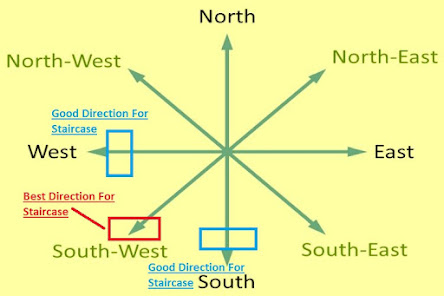In Vastu Shastra, an ancient Indian architectural and design system, the placement and design of staircases hold significant importance. Staircases play a crucial role in connecting different levels of a building and are believed to influence the flow of energy within a space. By adhering to Vastu guidelines for staircases, one can ensure the harmonious flow of energy, promote positivity, and create a balanced environment. Here's a comprehensive guide explaining the direction, location, and number of steps for stairs according to Vastu principles.
Direction of Staircase:
- Ideal Direction: According to Vastu, the ideal direction for a staircase is clockwise, which is from west to east or from south to north. This allows for the smooth flow of energy and is considered auspicious. Clockwise staircases are believed to bring positive energy and prosperity to the occupants of the building.
- Avoid Anti-Clockwise Direction: It is advisable to avoid constructing a staircase that is anti-clockwise, which is from east to west or from north to south. Such a direction is considered inauspicious in Vastu and may disrupt the natural flow of energy within the space.
Location of Staircase:
- Central or Southwest Location: The central or southwest area of the building is considered ideal for locating the staircase. This placement helps maintain stability and balance in the structure. The southwest corner is associated with the earth element, which symbolizes strength and support. Placing the staircase in this area is believed to provide a solid foundation and ensure stability for the entire building.
- Avoid Staircase in the Northeast: The northeast corner of a building is considered sacred in Vastu and is associated with positive energy and spiritual growth. It is advised to avoid constructing a staircase in this area, as it may disrupt the flow of positive energy and create imbalance. The northeast should ideally be kept open and clutter-free to allow for the unhindered flow of energy.
Number of Steps:
- Even Number of Steps: Vastu suggests that the number of steps in a staircase should preferably be even. It is believed that an even number of steps promotes balance and symmetry in the energy flow. However, if it is not feasible to have an even number, then the total number of steps should not end with zero or be divisible by three. For example, 10, 12, or 14 steps are considered favorable, while 15, 18, or 20 steps are to be avoided.
- Uniform Height and Width: For optimal Vastu compliance, it is important to ensure that the height and width of each step in the staircase are uniform. Irregularly sized steps can disrupt the smooth flow of energy and create an imbalance in the space.
- Avoid Spiral Staircases: Vastu discourages the use of spiral staircases, as they tend to create a whirlwind effect that disturbs the energy flow within a building. If a spiral staircase is necessary, it is recommended to have a solid wall on one side of the staircase to mitigate the disruptive energy.
Additional Tips:
- Lighting: Proper lighting is essential for staircases as it enhances the overall energy flow and safety. Ensure that the staircase is well-lit with bright, preferably natural, light during the day. At night, use soft and diffused lighting to create a welcoming and comfortable ambiance.
- Handrails: Staircases should be equipped with sturdy and well-designed handrails. Handrails provide support and safety while ascending or descending the stairs. They should be placed at an appropriate height and made of materials that complement the overall aesthetics of the building.
- Noise Reduction: Staircases can generate noise, especially in multi-level buildings. To minimize noise transmission, consider incorporating soundproofing materials or installing carpets or rugs on the steps. This helps create a quieter and more peaceful environment.
Sobha Neopolis Bangalore offers
an unrivaled living experience that combines opulence with comfort. Designed to
perfection, the project boasts an array of spacious and thoughtfully laid out
apartments, featuring 3BHK, 3.5BHK, and 4BHK configurations, catering to the
diverse needs and preferences of discerning homeowners.
While following Vastu guidelines for staircases can contribute to positive energy flow and a harmonious environment, it's important to adapt them to suit the practical constraints and layout of the building. Consulting with a qualified Vastu expert or architect can provide valuable insights and ensure the best implementation of these principles within your specific context.
Visit:
Govt to launch policy to use municipal waste to build roads: Gadkari





No comments:
Post a Comment